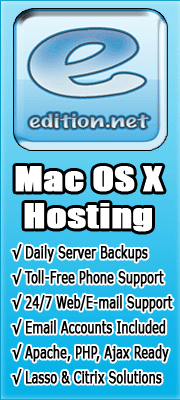Posts Tagged ‘BSD’
Mac OSX Server 10.4
Darwin: Kernel and BSD
Mac OS X Server starts with Darwin, the same open source foundation used in Mac OS X, Apples operating system for desktop and mobile computers. Darwin is built around the Mach 3.0 microkernel, which provides features critical to server operations, such as fine-grained multi-threading, symmetric multiprocessing (SMP), protected memory, a unified buffer cache (UBC), 64-bit kernel services and system notifications. Darwin also includes the latest innovations from the open source BSD community, particularly the FreeBSD development community.
Next-Generation Computing Power
Mac OS X Server v10.4 brings the power of 64-bit computing to mainstream servers opening up opportunities to process exponentially larger problems. Now with 64-bit addressing, Mac OS X Server can access massive amounts of memory, transcending the 4GB memory limitation of 32-bit systems. Its high-performance 64-bit file system enables you to create very large, exabyte-sized volumes for enormous databases and media storage. And its 64-bit optimized math libraries enable extremely accurate mathematical calculations. While Mac OS X Server is the ideal platform for next-generation networking applications and services, it also runs todays 32-bit applications natively no modification required.
Advanced BSD Networking
To increase the performance and security of your server deployments, Mac OS X Server incorporates industry-standard protocols and the latest in security standards such as multilink multihoming, IPv6, IPSec, IP over FireWire and 802.1X network authentication. New in Mac OS X Server v10.4 is Ethernet link aggregation and network interface failover (IEEE 802.3ad) for higher aggregated throughput and increased server availability. And with Mac OS X Server on Xserve G5, you also get support for Virtual Local Area Network (VLAN) tags and Ethernet Jumbo Frames. Using the time-tested BSD sockets and TCP/IP stack, these advanced networking features ensure compatibility and integration with IP-based networks.
Secure from the Start
Thanks to its UNIX foundation, Mac OS X Server contains robust security features in its core. To protect your server, your network and your organizations data, it also includes state-of-the-art technologies such as a built-in firewall with stateful packet analysis, strong encryption and authentication services, data security architectures and support for access control lists (ACLs) for fine-grained control of file system permissions. Simple interfaces and configuration tools allow you to set up systems easily and securely. In fact, when you take an Apple server out of the box, its already configured with the most secure settings.
Standards-Based Directory Services Architecture
Mac OS X Server features Open Directory, Apples directory and authentication services architecture. Open Directory allows you to integrate your server with any LDAP directory, leveraging the infrastructure you already have in place. It even integrates with proprietary services such as Microsofts Active Directory or Novell eDirectory. Also integrated is MITs Kerberos tcehnology, enabling single sign-on support in both Open Directory and Active Directory environments.
Optimized for Business-Critical Server Deployments
While Mac OS X Server has the same robust core as Mac OS X, it adds industrial-strength features required for server deployments. Designed for headless operation, Mac OS X Server enables you to install and configure services without connecting a monitor to the server. Powerful remote management tools allow you to securely manage services from anywhere on the network, and support for SSH2 provides secure access from the UNIX command line. To keep your systems up and running, Mac OS X Server has built-in tools for system monitoring, preventing accidental shutdown and recovering services quickly in case of network or power failure.
